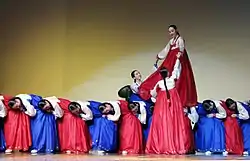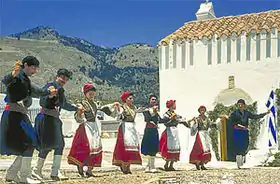Ganggangsullae
Ganggangsullae (Hangul: 강강술래) is an ancient Korean dance that was first used to bring about a bountiful harvest and has developed into a cultural symbol for Korea. It incorporates singing, dancing, and playing and is exclusively performed by women.[1] The dance is mostly performed in the southwestern coastal province of Jeollanam-do.[1][2] It is often associated with the Chuseok holiday and Daeboreum.[1] The performance starts with a late Ganggangsullae and changes to a 'Jajeun-Ganggangsullae', which are characterized by the most beautiful and feminine charms of late Ganggangsullae, and 'Jung-Ganggangsullae" only in the Haenam and Jindo provinces.
| Ganggangsullae | |
 | |
| Korean name | |
|---|---|
| Hangul | 강강술래 or 강강수월래 |
| Hanja | |
| Revised Romanization | Ganggangsullae or Ganggangsuwollae |
| McCune–Reischauer | Kanggangsullae or Kanggangsuwŏllae |
Etymology
The etymology of Ganggangsullae is not clear, however its origins can be guessed by interpreting the name in either Korean, Chinese characters, or a combination of Korean and Chinese characters.
Korean Letter Origin
'Gang' of Ganggangsullae means circle, and 'sullae' means a wagon, so together it means round and round.
Chinese Character Origin
It came from the word Ganggangsuallae, which means "a powerful barbarian is going to invade our country", which was a chant to make the public aware of enemy invaders.
Korean and Chinese Letter Origin
The origin related to Korean and Chinese character is similar to the Korean letter origin. 'Ganggang' means a round circle, and 'Sullae' comes from the Korean words 'Sunu' and 'Sulla'
History
Beginning
The dance is thought to have originated in ancient times when the Koreans believed that the Sun, Moon, and Earth controlled the universe. Participants would dance under the brightest full moon of the year in order to bring about a good harvest. Ganggangsullae has been held in Korea's most famous festivals like New Year's Day, Daeboreum, Dano, and Chuseok, which was largest at Chuseok. So, Ganggangsullae has become a popular event on Chuseok. On the evening of Chuseok, dozens of young farming women dance with their hands held together, singing and dancing.[3]
Feature of Korea's traditional society
Korea’s traditional society was a male-dominated society, and young women were not allowed to sing loudly or go out at night. But women were allowed to sing and dance by doing “ganggangsullae” at night and give vent to their frustration at Chuseok. Women could enjoy the atmosphere free from normal restrictions during the festival.
In the 16th century, during the Japanese invasion of Korea, Admiral Yi Sun-sin ordered women to do this dance in military uniform to intimidate the Japanese. The women were said to have dressed in military uniform and danced on Mount Okmae (옥매산). The Japanese scouts thus overestimated the strength of the Korean troops.[4][5][6][7]
On February 15, 1966, ganggangsullae was designated as Important Intangible Cultural Properties of Korea #8.[2]
How to Perform Ganggangsullae
Wonmu
It is the main action of Ganggangsullae, which is spinning counterclockwise.
Holding hands and Walking
When holding hands with each other, the back of the right hand should be above, and the palm of the left hand should be above. When walking, the heel should be on the ground first.
Running
People doing 'running' have to run faster than 'walking'. They shouldn't open their legs very much, and they have to raise their knees while running.
Gatekeeper Play
Except the first two person, they make a line to be ready to go through the gate. The first and second person makes the gate, and then the right next person who went through the gate makes the gate, while the person who made the gate returns to the line.
Stomping Roof Tile
Except three people, they stand in a line lowering their heads. One person stands on their waist and starts to walk on them. The other two people holds her hands not to fall down.
Regional aspect of Ganggangsullae
Ganggangsullae is often handed down as a frame with Ganggangsullae, and is handed down independently, depending on the region. In this way, the patterns of existence of Ganggangsulrae vary depending on the area, and the meaning given to Ganggangsulla varies according to the region.
Function and Meaning of Ganggangsullae[8]
Ritualistic Function
On the full moon night, there is a meaning of praying for the abundance and praise of the moon Ganggangsullae. At present, the meaning of the proposal is not strong, but it is presumed that the origin and departure of Ganggangsullae originated from the merit. Ganggangsullae's offerings differ slightly depending on tradition. In other words, in the region considered to be the central part, the quality remains stronger than the peripheral part. For example, steels are not in the periphery. So there is no ceremonial process of going from the Jin Ganggang to the Kang Ganggang.
Function and meaning of the origin of affluence
In the Shinan area, Ganggangsullae is said to have played not only with women's plays but with men and women playing together. It can be said that Ganggangsullae is responsible for the function of mating. It also means praying for the abundance toward the moon.
Function and meaning of Kanggangsullae related to the Japanese Invasion
The well - known Kanggangsullae 's theory of Imjinwaeran remains centered on Jindo and Haenam. During the Japanese invasion of Imjin, women changed their clothes and turned around Ganggangsullae.
Function and meaning as play song
In the surrounding area, Ganggangsullae is played as a play song. Heroic weaving, the end of virtue, treadmill tilting, and the birth of a child were also made for educational purposes. It is a representative meaning of Ganggangsullae in the 21st century.
Function and meaning as cultural property
Ganggangsullae is designated as the Intangible Cultural Property No. 8 of Korea. Now Ganggangsullae has become one of the performances. Ganggangsullae is a cultural asset that has a lot of music and power to pass down.
Characteristics

Traditionally, this dance is performed only by women at night without any instruments. Young and old women dance in a circle at night under the moonlight. They go outside in traditional Korean clothing, hold each other's hands, make a circle, and start rotating clockwise. The lead singer sings a line and everyone sings the refrain 'ganggangsullae'. The song tempo progressively becomes faster. They sing about their personal hardships, relationships, and desires. During the dance, the women play a variety of games. The dance can last until dawn.[7]
References
- I-hwa Yi (2006). Korea's pastimes and customs: a social history. Homa & Sekey Books. pp. 79–92. ISBN 978-1-931907-38-5. Retrieved 25 July 2011.
- "Ganggangsullae Dance". Archived from the original on 2011-06-13.
- "강강술래 | 유네스코와 유산". heritage.unesco.or.kr (in Korean). Retrieved 2017-12-01.
- "Ganggang Sullae, Thanksgiving Day Festival".
- "Ganggangsullae of Sopo". Archived from the original on 2009-06-09.
- "Ganggangsullae". Archived from the original on 2011-06-10.
- Lee E-hwa (2006). Korea's pastimes and customs: A Social History. Ju-Hee Park (trans.). Homa & Sekey Books. pp. 170–172. ISBN 1-931907-38-2.
- "DBpia". www.dbpia.co.kr (in Korean). Retrieved 2017-11-30.
